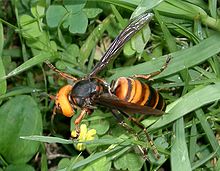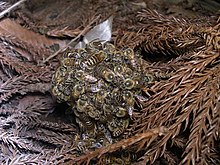Asian giant hornet: Difference between revisions
No edit summary |
No edit summary |
||
| Line 29: | Line 29: | ||
|title= MORPHOLOGICAL AND TAXONOMIC STUDIES ON VESPINE LARVAE, WITH REFERENCE TO THE PHYLOGENY OF THE SUBFAMILY VESPINAE (HYMENOPTERA : VESPIDAE) |
|title= MORPHOLOGICAL AND TAXONOMIC STUDIES ON VESPINE LARVAE, WITH REFERENCE TO THE PHYLOGENY OF THE SUBFAMILY VESPINAE (HYMENOPTERA : VESPIDAE) |
||
|journal= New series | volume=8 |pages=1-45 |
|journal= New series | volume=8 |pages=1-45 |
||
}}</ref> It feeds primarily on larger insects and honey from honey bee colonies. <ref>{{{{cite web |
|||
|url= http://eol.org/data_objects/26420945 |
|||
|title= ''Vespa Mandarinia'' |
|||
|last1=Campbell |
|||
|first1=Dana |date=11 November 2014 |
|||
|website= Encyclopedia of Life |
|||
|accessdate=16 September 2014 |
|||
}}</ref> Its body length is approximately {{convert|50|mm|in|0|abbr=on}}, its wingspan is about {{convert|76|mm|in|0|abbr=on}},<ref name="ngeo">{{cite web |
}}</ref> Its body length is approximately {{convert|50|mm|in|0|abbr=on}}, its wingspan is about {{convert|76|mm|in|0|abbr=on}},<ref name="ngeo">{{cite web |
||
| url=http://news.nationalgeographic.com/news/2002/10/1025_021025_GiantHornets.html |
| url=http://news.nationalgeographic.com/news/2002/10/1025_021025_GiantHornets.html |
||
Revision as of 01:00, 24 September 2014
| Asian giant hornet | |
|---|---|

| |
| Adults engaging in trophallaxis | |
| Scientific classification | |
| Kingdom: | |
| Phylum: | |
| Class: | |
| Order: | |
| Family: | |
| Genus: | |
| Species: | V. mandarinia
|
| Binomial name | |
| Vespa mandarinia Smith, 1852
| |
The Asian giant hornet (Vespa mandarinia), including the subspecies Japanese giant hornet (Vespa mandarinia japonica),[1] colloquially known as the yak-killer hornet,[2] is the world's largest hornet, native to temperate and tropical Eastern Asia. They prefer to live in low mountains and forests while almost completely avoiding plains and highly elevated climates. Nests are created either by digging, coopting preexisting tunnels dug by rodents or occupying spaces near rotted pine roots.[3] It feeds primarily on larger insects and honey from honey bee colonies. [4] Its body length is approximately 50 mm (2 in), its wingspan is about 76 mm (3 in),[5] and its 6 mm (0.24 in) stinger injects a large amount of potent venom.
Anatomy
The head of the hornet is orange and quite wide in comparison to other hornet species. The compound eyes and ocelli are dark brown, and the antennae are dark brown with orange scapes. The clypeus (the shield-like plate on the front of the head) is orange and coarsely punctured; the posterior side of the clypeus has narrow, rounded lobes. The mandible is large and orange with a black tooth (inner biting surface) that is used for burrowing.
The thorax and propodeum (the abdominal segment that is fused with the posterior segment of the thorax) of the Asian giant hornet has a distinctive golden tint and a large scutellum (a shield-like scale on the thorax) that has a deeply impressed medial line; the postscutellum (the plate behind the scutellum) bulges and overhangs the propodeum. The hornet's forelegs are orange with dark brown tarsi (the distal—furthest down—part of the leg); the midlegs and hindlegs are dark brown. Wings are a dark brownish-gray. The tegulae are brown.
The gaster (the portion of the abdomen behind the thorax–abdomen connection) is dark brown with a white, powdery covering; with narrow yellow bands at the posterior margins of the tergite, the sixth segment is entirely yellow. It is similar in appearance to the European hornet, Vespa crabro, and other members of the genus.
Geographic distribution


It can be found in the Primorsky Krai region of Russia, Korea (where it is called 장수말벌; "Commander wasp"), China, Taiwan (where it is called 虎頭蜂; "tiger head bee"), Indochina,Thailand, Nepal, India,Vietnam and Sri Lanka, but is most common in rural areas of Japan, where it is called giant sparrow bee (大雀蜂 or オオスズメバチ).
Sting
The stinger of the Asian giant hornet is about 6 mm (¼ in) in length,[5] and injects an especially potent venom that contains, like many bee and wasp venoms, a cytolytic peptide (specifically, a mastoparan) that can damage tissue by stimulating phospholipase action,[6] in addition to its own intrinsic phospholipase.[7] Masato Ono, an entomologist at Tamagawa University near Tokyo, described the sensation as feeling "like a hot nail being driven into my leg".[5]
An allergic human stung by the giant hornet may die from an allergic reaction to the venom.
The venom contains a neurotoxin called mandaratoxin (MDTX),[8] a single-chain polypeptide with a molecular weight of approximately 20 kD,[9] which can be lethal even to people who are not allergic if the dose is sufficient.
Each year in Japan, the human death toll caused by Asian giant hornet stings is around 30 to 40.[10][11][12]
Advice in China is that people stung more than 10 times need medical help, and emergency treatment for more than 30 stings. The stings can cause renal failure.[13] Stings by Asian giant hornets killed forty-one people and injured more than 1,600 people in Shaanxi province, China in 2013.[14]
Predation
The Asian giant hornet is intensely predatory; it hunts medium- to large-sized insects, such as bees, other hornet species, and mantises.

The hornets often attack hives to obtain the honey bee larvae as food for their own larvae. A single scout, sometimes two or three, will cautiously approach the hive, producing pheromones to lead its nest-mates to the hive. The hornets can devastate a colony of honey bees: a single hornet can kill as many as 40 honey bees per minute thanks to its large mandibles which can quickly strike and decapitate a bee. The honeybee stings are ineffective because the hornets are five times the size and too heavily armoured. It takes only relatively few of these hornets (under 50) a few hours to exterminate a colony of tens of thousands of bees. The hornets can fly up to 100 kilometres (60 mi) in a single day, at speeds of up to 40 km/h (25 mph)[15]
Hornet larvae, but not adults, can digest solid protein; the adult hornets chew their prey into a paste that they feed to their larvae. Larvae of predatory social vespids generally (not just Vespa) secrete a clear liquid, vespa amino acid mixture, whose exact amino acid composition varies considerably from species to species, which they produce to feed the adults on demand.[16]
Native honey bees

Beekeepers in Japan attempted to introduce European honey bees (Apis mellifera) for the sake of their high productivity. European honeybees have no innate defense against the hornets, which can rapidly destroy their colonies.[17]
Although a handful of Asian giant hornets can easily defeat the uncoordinated defenses of a honey bee colony, the Japanese honey bee (Apis cerana japonica) has an effective strategy. When a hornet scout locates and approaches a Japanese honey bee hive, she emits specific pheromonal hunting signals. When the Japanese honey bees detect these pheromones, a hundred or so gather near the entrance of the nest and set up a trap, keeping the entrance open. This permits the hornet to enter the hive. As the hornet enters, a mob of hundreds of honey bees surrounds it in a ball, completely covering it and preventing it from reacting effectively. The bees violently vibrate their flight muscles in much the same way as they do to heat the hive in cold conditions. This raises the temperature in the ball to the critical temperature of 46 °C (115 °F). In addition, the exertions of the honey bees raise the level of carbon dioxide (CO2) in the ball. At that concentration of CO2, the honey bees can tolerate up to 50 °C (122 °F), but the hornet cannot survive the combination of a temperature of 46 °C (115 °F) and high carbon dioxide level.[18][19] Some bees do die along with the intruder, much as happens when they attack other intruders with their stings, but by killing the hornet scout they prevent it from summoning reinforcements that would wipe out the entire colony.[20]
Detailed research suggests that this account of the behaviour of the bees and a few species of hornets is incomplete and that the bees and the predators are developing strategies to avoid expensive and mutually unprofitable conflict. Instead, when bees detect scouting hornets they transmit an "I see you" signal that commonly warns off the predator.[21]
Hornet supplement manufacturers
Several companies in Asia and Europe have begun to manufacture dietary supplements and energy drinks which contain synthetic versions of secretions of the larvae of Vespa mandarinia, which the adult hornets usually consume. The manufacturers of these products make claims that consuming the larval hornet secretions (marketed as "hornet juice") will enhance human endurance because of the effect it has on adult hornets' performance. Because these products are marketed as dietary supplements rather than pharmaceuticals, they do not have to support their claims. Some studies have suggested that the vespa amino acid mixture itself may influence animal performance in minor ways.[22]
References
- ^ Piper, Ross (2007). Extraordinary Animals: An Encyclopedia of Curious and Unusual Animals. pp. 9–11. ISBN 978-0-313-33922-6.
- ^ Backshall, Steve (2007). Steve Backshall's venom: poisonous animals in the natural world. New Holland Publishers. ISBN 1-84537-734-6.
- ^ Yamane, Seiki (1976). "MORPHOLOGICAL AND TAXONOMIC STUDIES ON VESPINE LARVAE, WITH REFERENCE TO THE PHYLOGENY OF THE SUBFAMILY VESPINAE (HYMENOPTERA : VESPIDAE)". New series. 8: 1–45.
- ^ {{Campbell, Dana (11 November 2014). "Vespa Mandarinia". Encyclopedia of Life. Retrieved 16 September 2014.
- ^ a b c Handwerk, Brian (October 25, 2002). ""Hornets From Hell" Offer Real-Life Fright". National Geographic News. Archived from the original on 25 January 2010. Retrieved January 2010.
{{cite web}}: Check date values in:|accessdate=(help); Unknown parameter|deadurl=ignored (|url-status=suggested) (help) - ^ Hirai, Y.; Yasuhara, T.; Yoshida, H.; Nakajima, T. (1981). "A new mast cell degranulating peptide, mastoparan-M, in the venom of the hornet Vespa mandarinia". Biomed. Res. 2: 447–449.
- ^ Abe, T.; Sugita, M.; Fujikura, T.; Hiyoshi, J.; Akasu, M. (2000). "Giant hornet (Vespa mandarinia) venomous phospholipases – The purification, characterization and inhibitory properties by biscoclaurine alkaloids". Toxicon. 38 (12): 1803–1816. doi:10.1016/S0041-0101(00)00109-4.
- ^ Abe, T.; Kawai, N.; Niwa, A. (1982). "Purification and properties of a presynaptically acting neurotoxin, mandaratoxin, from hornet (Vespa mandarinia)". Biochemistry. 21 (7): 1693–1697. doi:10.1021/bi00536a034.
- ^ BioInfoBank Library. "Purification and properties of a presynaptically acting neurotoxin, mandaratoxin, from hornet (Vespa mandarinia)". Lib.bioinfo.pl. Retrieved 2013-03-18.
- ^ アレルギー対策について 厚生労働省
- ^ わが国における蜂刺症 The Topic of This Month Vol.18 No.8(No.210) 国立感染症研究所
- ^ According to "わが国における蜂刺症 The Topic of This Month Vol.18 No.8(No.210) 国立感染症研究所", this number includes fatalities from other bees and wasps.
- ^ Guardian newspaper: Hornet attacks kill dozens in China, 26 September 2013
- ^ BBC: China hornets kill 41 in north since July
- ^ Dieter Kosmeier (2013-01-27). "''Vespa mandarinia'' (Asian Giant Hornet) page". Vespa-crabro.de. Retrieved 2013-03-18.
- ^ Hunt, J. H.; Baker, I.; Baker, H. G. (1982). "Similarity of amino acids in nectar and larval saliva: the nutritional basis for trophallaxis in social wasps". Evolution. 36 (6): 1318–1322. JSTOR 2408164.
- ^ Piper, Ross (2007), Extraordinary Animals: An Encyclopedia of Curious and Unusual Animals, Greenwood Press.
- ^ Sugahara, Michio; Sakamoto, Fumio (September 2009). "Heat and carbon dioxide generated by honeybees jointly act to kill hornets". Naturwissenschaften. 96 (9): 1133–1136. doi:10.1007/s00114-009-0575-0.
- ^ "Honeybee mobs overpower hornets". BBC News. July 3, 2009. Retrieved April 25, 2010.
- ^ "Defensive Adaptations: Heat Tolerance As A Weapon". Bio.davidson.edu. Retrieved 2013-03-18.
- ^ Tan Ken, et al (2011), An ‘I see you’ prey–predator signal between the Asian honeybee, Apis cerana, and the hornet, Vespa velutina , Animal Behavior.
- ^ Demura, S.; Nagasawa, Y.; Kitabayashi, T.; Matsuzawa, J. (2003). "Effect of amino acid mixture intake on physiological responses and rating of perceived exertion during cycling exercise". Percept Mot Skills. 96 (3 Pt 1): 883–895. doi:10.2466/pms.2003.96.3.883. PMID 12831267.
External links
- The Asian Giant Hornet
- Yellowjackets and hornets
- Heat Tolerance as a Weapon
- Video footage at National Geographic

